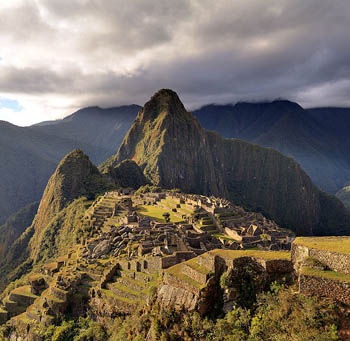|
Machu Picchu, Peru is a World Heritage Site that is full of mystery and architectural marvel. One of the new Seven Wonders of the World it was built around 1460. The Lost City of the Incas is 7,875 feet (2,400 meters) above sea level on a mountain ridge overlooking the Urubamba Valley. It is conjectured that it was used by Incan Emperors as a retreat, but it was abandoned after only 100 years. Why would they take such great effort to build a beautiful, complicated city and leave it forever, only to be found by chance in 1911 by an American historian, Hiram Bingham?
Other explorers were there before, but Hiram Bingham brought it to the attention of the world and National Geographic devoted a whole issue to the city in April 1913. The Spanish never found it. This is proved by the presence of the Intihuatana stone which was destroyed everywhere the Spanish found one. This stone is considered to be an astronomic calendar or clock.
 Machu Picchu is built in three distinct areas: one for agriculture, one for living and one for religious practices. The function of the buildings and the form of the surrounding countryside coincide to take advantage of natural slopes. The religious buildings are on the crest of the mountain overlooking the Urubamba River, the valley and the rest of the Andes Mountains. Machu Picchu is built in three distinct areas: one for agriculture, one for living and one for religious practices. The function of the buildings and the form of the surrounding countryside coincide to take advantage of natural slopes. The religious buildings are on the crest of the mountain overlooking the Urubamba River, the valley and the rest of the Andes Mountains.
The stone used for building was brought from long distances and cut so perfectly it fits together without mortar. There is evidence of earthquake protection which is one reason it is still standing for visitors to see today.
To reach Machu Picchu visitors take a train from Cusco to Puente Ruinas. The train zigzags up the Picchu mountain until it reaches El Arco (the arch) and then descends through several villages through the gully of Pomatales to the Sacred Valley of the Incas. It then crosses the river and arrives at Ollantaytambo. Here, those who came along the road can board the train to Machu Picchu. Finally, it reaches massive granite mountains and dives into two tunnels to arrive at Puente Ruinas. Minibuses take visitors up the 8 kilometers to the Tourist Hotel. This is near the control room of the city. The train only runs during the high season from April to October.
The control gate is a three-walled room with a spectacular view of the agriculture and urban areas and it is the best place from which to take photos. There are guided tours of the city that enter the citadel through the rooms near the outer wall and pass through a terrace to the agricultural zone.
Located in a subtropical zone with dense wood, it has a mild, warm and damp climate. It averages 13C during the day. The dry season is from April to October which is the preferred season for tourists. The rainy season from November to March is also open to tourists.
Machu Picchu is one of the most important places to visit in South America. Shrouded in clouds that add to the mystery, the city has a powerful effect on everyone who sees it. Probably somewhat similar to what the Incans felt who lived there.
Most travelers to Machu Picchu arrive by plane, flying first to Lima’s Jorge Chavez International Airport and then transfer to a domestic flight bringing them to Cusco’s Alejandro Velesco Astete International Airport.
|